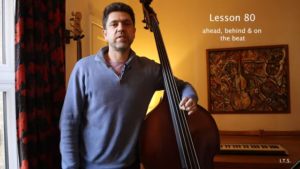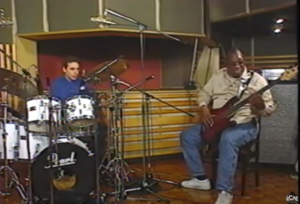CHAPTER 6: RUBATO(ルバート)
Rubato – general issues(ルバートについて - 一般的な問題)
Half the battle is for the accompanist to know the song, so that he can anticipate this rubato.40 – Gerald Moore
「ルバートを予期するためには、伴奏者が曲を知っていることが半分の戦いである」とジェラルド・ムーア
Working with vocalists in rubato sections, either in short passages or an entire piece, can be the most challenging aspect of accompanying. The accompanist must make split-second decisions concerning whether to lead by suggestion, to follow or precisely match the vocalist’s phrasing. In many cases, decisions are based on the style, preference and experience level of the vocalist. In classical music, rubato sections are ordinarily worked out in advance. This can also be the case in jazz. More often, however, in jazz performance practice rubato is more of a give-and-take affair. Rubato is a constant striving for blend and balance for both the vocalist and accompanist.
歌手と一緒に短いパッセージまたは全曲にわたって自由なリズムを演奏することは、伴奏の中でも最も難しい面の1つです。伴奏者は、歌手のフレージングを提案したり、追従したり、正確に合わせたりするかを瞬時に決定しなければなりません。多くの場合、この決定は、歌手のスタイル、好み、そして経験レベルに基づいて行われます。クラシック音楽では、ルバートのセクションは通常事前に練習されます。これはジャズでも同様です。しかしながら、ジャズの演奏においては、ルバートはより柔軟なやり取りの一部となっています。ルバートは、歌手と伴奏者の両方にとって調和とバランスを目指す絶え間ない取り組みです。
Sometimes it is appropriate for the accompanist in rubato sections to move passages along by pressing the tempo ahead at the end of a vocalist’s phrase. This allows the singer to finish a phrase without having to take another breath that may destroy the integrity of the melodic line. In The Art of Accompanying, Algernon Lindo suggests that such phrases should be played with a “stringendo or agitato effect.”41 To aid the singer, the accompanist may be required “to make a slight accelerando (so slight that it is imperceptible to the listener) as he nears the end of the phrase if he feels that the singer’s breath is giving out.”42 This moves the piece along without drawing too much attention to the piano. In order to do this, the accompanist must learn to judge the breath capacity of the singer.
時には、ルバートのセクションにおいて伴奏者がボーカリストのフレーズの終わりにおいてテンポを若干速めることは適切です。これにより、歌手はフレーズを終えることができ、旋律の一体性を損なわずに別の息継ぎをする必要がありません。『伴奏の技法』という本で、アルジャーノン・リンドは、そのようなフレーズを「ストリンジェンドまたはアジタートの効果」で演奏することを提案しています。歌手を支援するために、伴奏者は「もし歌手の息が切れてきたと感じた場合、フレーズの終わりに近づくにつれてわずかなアクセルを加える(リスナーにはほとんど気づかれないほどわずかなもの)」ことが求められるかもしれません。これにより、曲は進行しますが、ピアノにあまり注意を引かれることはありません。これを行うためには、伴奏者は歌手の息の持ち方を判断する能力を身につける必要があります。
The same device can be used in the jazz setting. Though an accompanist can lead by suggestion, following the singer’s intentions is common practice more often than not. Bill Charlap suggests “in out-of-tempo playing, it's the accompanist's job to follow.
Allow the vocalist to control the pacing.” Charlap maintains, however, that there are other times when leading is appropriate: “You must also know when to subtly lead by suggestion. Try to pare down the harmonic rhythm to its essentials. Don't play more than is needed.”43
同じ手法はジャズの状況でも使用されることがあります。伴奏者は提案によって先導することができますが、歌手の意図に従うことが一般的な慣習です。ビル・シャーラップは「テンポのない演奏では、伴奏者の仕事は歌手に従うことです。歌手がペーシングを制御することを許してください。」と述べています。しかし、シャーラップは、他の時に微妙に先導することが適切な場合もあると主張しています。「和声のリズムを本質的な要素に絞り込むように心掛けてください。必要以上に演奏しないでください。」
Accompanists must be sensitive to the fact that many jazz vocalists will vary the pace of their phrasing in rubato sections. John di Martino learned a great deal about playing rubato while working with drummer/vocalist Grady Tate. With Tate, he learned the importance of keeping pace with the singer at all times: “He likes you to absolutely mirror him, never get ahead.” He learned to “surrender to the moment and shadow” just as Tate at times would hold notes, or sing melismatically on others. di Martino calls this a “conversational approach to rubato.”
伴奏者は、ジャズのボーカリストがルバートのセクションでフレージングのペースを変えることが多いという事実に敏感である必要があります。ジョン・ディ・マルティノは、ドラマー兼ボーカリストのグレイディ・テイトとの共演を通じて、ルバートの演奏について多くのことを学びました。テイトと一緒にいるとき、彼は常に歌手とのペースを合わせることの重要性を学びました。「彼はあなたが彼を完全に反映するのが好きで、決して先行しないようにします。」彼は、時にテイトが音を保持したり、メリスマ的に歌ったりするのに合わせて、「その場に身を任せ、影を追う」ことを学びました。ディ・マルティノはこれを「ルバートに対する対話的なアプローチ」と呼んでいます。
di Martino stresses that an accompanist will do best by simplifying the chord changes in rubato passages by leaving chords out because a singer may move quickly through a section, as Charlap suggests. di Martino notes that certain vocalists such as Freddy Cole sang quickly through verses, similar to an opera recitative that precedes a aria. For example, in the verse to “I Got Lost in Her Arms” on Because of You, di Martino closely follows Cole with solid chords, adding the occasional simple fill. As a word of advice, he notes that an effective rubato approach is to “just play a color, with no fills or lines – you can do no wrong.”44
ディ・マルティーノは、伴奏者はルバートのパッセージにおいて、コードの変化を単純化することによって最善の結果を得ることができると強調しています。なぜならば、シャーラップが指摘するように、歌手はセクションを素早く進むことがあるからです。ディ・マルティーノは、フレディ・コールなどの一部のヴォーカリストが、アリアに先立つオペラのレチタティーヴォのように、詩の部分を速く歌っていると指摘しています。例えば、「Because of You」の「I Got Lost in Her Arms」という詩では、ディ・マルティーノはコールに密接に従い、しっかりとしたコードを使い、時折シンプルなフィルを追加しています。助言として、彼は効果的なルバートのアプローチは「ただ色を奏でることで、フィルやラインは必要ありません - 何をやっても間違いはありません」と述べています。
From a philosophical standpoint, Halberstadt believes that playing rubato is about following the vocalist. He notes, “The singer should be focusing on the message of the lyrics and how she can pace them most effectively. She doesn’t need me to be ‘suggesting’ pacing by what I play.” However, the process should never equate to dragging: “If the singer wants to rush through a phrase, I’ll be right there with her.” Like di Martino, Halberstadt occasionally pares down the harmonic progression of the song to accommodate the words of the singer: “Sometimes that requires simplifying the chord progression: the melodic phrase may not flow smoothly at a fast clip if I include all six written chords, so I’ll take some out.” At other times, Halberstadt plays the chord changes in between the melodic phrases quickly enough so that the vocalist is not waiting for him to finish, as Gerald Moore suggests. This may again involve removing excess passing chords.
One specific approach for creating a comfortable harmonic environment for the vocalist during rubato passages is to sustain a mid-range chord, then fill with octaves in a higher register at points of rest. A sustained, unobtrusive harmonic carpet is ideal for clarity of the vocalist’s diction. Bill Miller used this approach when he accompanied Frank Sinatra during the rubato verse of “A Foggy Day” on Songs for Young Lovers.
When the melody is active he tends to hold chords with little or no harmonic motion:
ハルバースタットは、哲学的な観点から見ると、ルバートの演奏は歌手に従うことだと考えています。彼は次のように述べています。「歌手は歌詞のメッセージと、それを最も効果的に進める方法に集中すべきです。私が演奏することで、彼女に進行の「提案」をする必要はありません。」ただし、このプロセスは決して引きずることとは同義ではありません。「もし歌手がフレーズを急いで歌いたいのなら、私もそれに合わせます。」ディ・マルティーノと同様に、ハルバースタットも時折、歌手の言葉に合わせて曲の和声進行を簡略化することがあります。「時には和声進行を簡素化する必要があります。もしすべての六つの記述されたコードを含めると、早いテンポでメロディックなフレーズがスムーズに流れないかもしれないため、一部を省略します。」また、ハルバースタットは、ジェラルド・ムーアが提案するように、歌唱者が自分の演奏が終わるのを待たないように、メロディックなフレーズの間のコードの変化を速く演奏することもあります。これには再び余分な通過コードを省くことが含まれる場合もあります。 ルバートのパッセージ中に歌手に快適な和声環境を作るための具体的なアプローチの一つは、中音域のコードを持続させ、休止点で高いレジスターでオクターブで埋めることです。持続的で目立たない和声のカーペットは、歌手の発音の明瞭さのために理想的です。ビル・ミラーは、「Songs for Young Lovers」の「A Foggy Day」のルバートの詩の中で、フランク・シナトラを伴奏する際に、このアプローチを使用しました。 メロディが活発な場合、彼は和声の動きがほとんどないコードを保持する傾向があります。
Example 6.1. Bill Miller, “A Foggy Day” (George and Ira Gershwin, 1937), introduction.
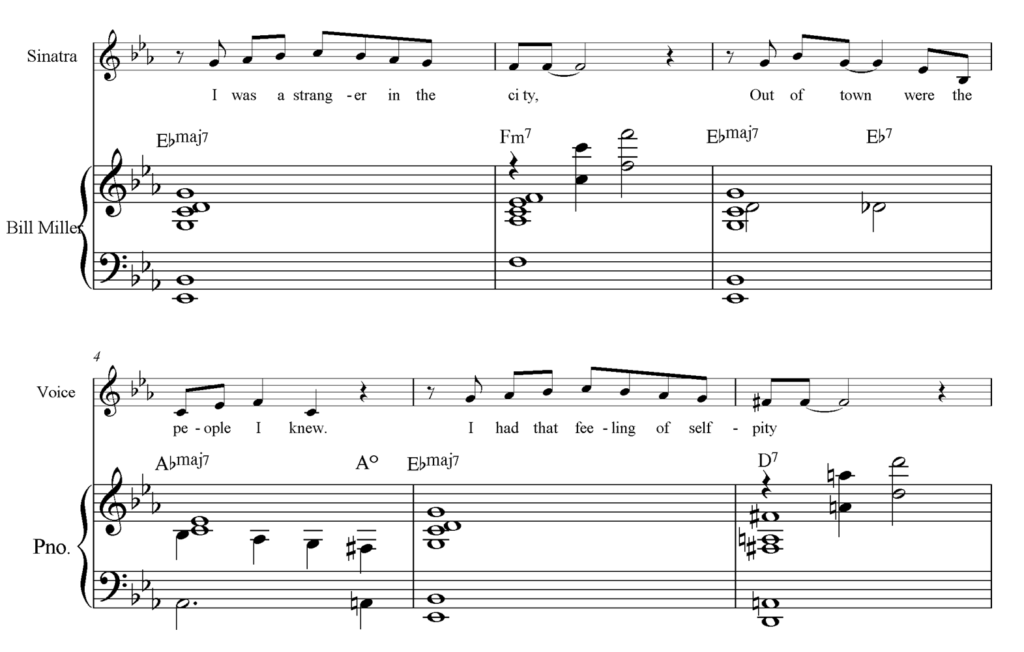
Frank Sinatra / Songs For Young Lovers - A Foggy Day
Many vocalists prefer simplicity during rubato sections, without the clutter of complicated fills. Playing a chord at structurally important times such as at key points in the lyrics is a useful approach, as Bill Miller was inclined to do with Sinatra. During these sections Gunnison states it is important “to know the lyric and the phrasing of the lyric. Carmen and I never discussed this topic but she'd let me know something was wrong by giving me the ‘eye’ on stage.” Gunnison’s rubato accompaniment of Carmen McRae on “Round Midnight” on Carmen Sings Monk aptly demonstrates his awareness of the lyrics. McRae takes liberties with her phrasing, but Gunnison is with her at every turn, lining up his chords with the key words in the phrase. His voicings appropriately lie in a lower register to suit the mood of the song and are never intrusive to the vocal line. Instead of doubling the melody, the voicings surround it in a supportive way:
ルバートのセクションでは、多くのヴォーカリストが複雑なフィルを避け、シンプルさを好む傾向があります。歌詞の重要な部分であるキーポイントでコードを演奏するというアプローチは有用です。これは、ビル・ミラーがシナトラと一緒にする傾向があった方法です。これらのセクションでは、ガニソンは「歌詞とフレーズのフレージングを知ることが重要です。カーメンと私はこのトピックを話し合ったことはありませんが、彼女はステージで私に「目」で何かが間違っていることを伝えてくれました。」と述べています。ガニソンは、カーメン・マクレイとの「Carmen Sings Monk」での「Round Midnight」のルバートの伴奏によって、歌詞への意識をうまく示しています。マクレイはフレージングで自由度を持っていますが、ガニソンは彼女のあらゆる転換点で彼女と一緒にいます。フレーズのキーワードに合わせてコードを整列させます。彼のヴォイシングは曲のムードに合わせて適切な低いレジスターに位置し、ヴォーカルラインには侵入的ではありません。メロディを倍音する代わりに、ヴォイシングは支持的な形でメロディを取り巻きます:
Example 6.2. Eric Gunnison, “Round Midnight” (Monk/Hanighen, 1944), rubato accompaniment.45
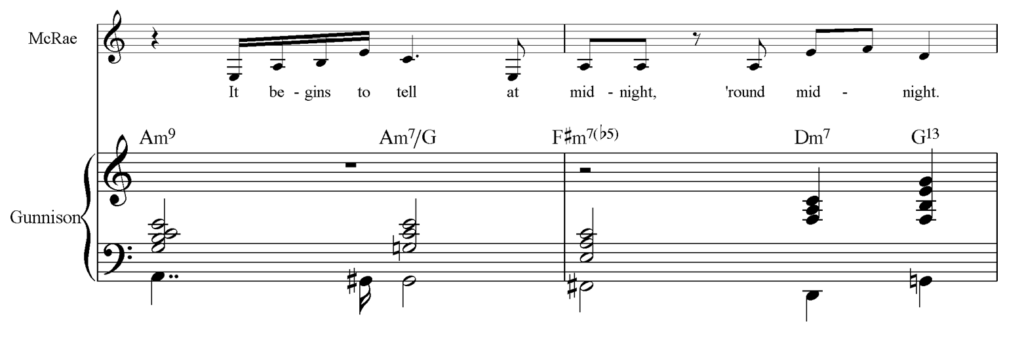
Carmen McRae / Carmen Sings Monk - Round Midnight
Rubato sections can leave the accompaniment particularly exposed. As previously mentioned, Chick Corea noted that the pianist’s part must make musical sense on its own. One way to achieve coherence within the accompaniment is to maintain a sense of melodic integrity within the voicings so that the top note creates a smooth melodic line. In “The Boy Next Door” on The Boy Next Door, David Newton provides a pleasing countermelody with the top notes of his chords, all the while closely following vocalist Stacey Kent, whom he states “always led”:
ルバートのセクションでは、伴奏は特に露出してしまうことがあります。先にも述べたように、チック・コリアは、ピアニストのパートは単体で音楽的な意味を持たなければならないと指摘しています。伴奏の中で統一感を持たせる方法の一つは、ヴォイシング内でメロディの一体性を維持し、最上部の音が滑らかなメロディラインを作ることです。デビット・ニュートンは「The Boy Next Door」(The Boy Next Door)で、ヴォーカリストのステイシー・ケントに密接に従いながら、彼のコードの最上部の音で心地よい対旋律を提供しています。彼は彼女が常にリードしていると述べています。
Example 6.3. David Newton’s accompaniment on “The Boy Next Door” (Martin/Blaine, 1944), introduction.
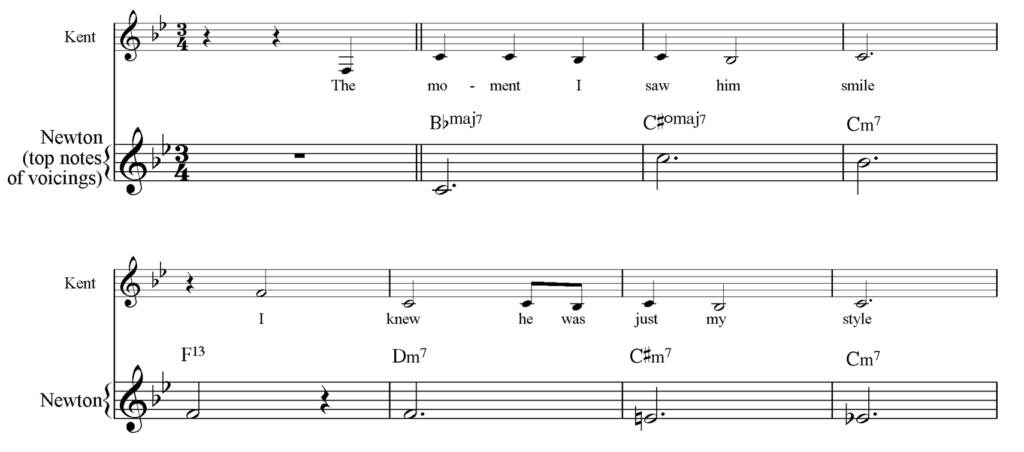
Stacy Kent / The Boy Next Door - The Boy Next Door
While some vocalists like Kent preferred to lead a rubato section, in Hobgood’s experience, some vocalists prefer a combination of leading and following. Hobgood asserts that knowledge of the melody is a tremendous aid; one must know the phrase points where the singer is expecting something from the piano. This sense of anticipation comes from repeated performances or prior knowledge of the song. In the rubato introduction of Kurt Elling on “Nature Boy” on The Messenger, Hobgood mainly follows Elling, yet in certain moments such as at 0:25 after the phrase “at sea” Elling waits for Hobgood to provide a harmonic cadence.
ケントのような一部のヴォーカリストは、ルバートのセクションをリードすることを好む一方で、ホブグッドの経験では、一部のヴォーカリストはリードとフォローを組み合わせることを好むと述べています。ホブグッドは、メロディの知識が非常に役立つと主張しています。歌手がピアノから何かを期待しているフレーズのポイントを知る必要があります。この予測感は、繰り返しの演奏や曲の事前の知識から得られます。アルバム「The Messenger」の「Nature Boy」でのカート・エリングのルバートのイントロでは、ホブグッドは主にエリングに従っていますが、0:25のフレーズ「at sea」の後など、エリングはホブグッドに和声の終止を提供するのを待っています。
Kurt Elling / The Messenger - Nature Boy
Dunlap says the process of following and leading is conditional, and the accompanist should lead only when necessary. For Jacob, rubato playing is “really a question of matching your music flow with the singer’s flow. The singer has to deal with lyric deployment, which you don’t, so you have to let him or her lead, but you have to keep an eye on the flow, and don’t let it die.” A good example of Jacob’s rubato style is his accompaniment of Tierney Sutton on “Only the Lonely” from Dancing in the Dark. Jacob mostly follows Sutton using lightly placed spacious sounding chords with wide intervals. He is never intrusive and matches Sutton’s mood well.
Dunlapは、リードとフォローのプロセスは条件付きであり、伴奏者は必要なときにのみリードすべきだと述べています。Jacobにとって、ルバートの演奏は「本当にあなたの音楽の流れを歌手の流れに合わせる問題です。歌手は歌詞の展開に対処しなければならないが、あなたはしなくてよいので、彼または彼女にリードさせる必要がありますが、流れに目を配り、それが途切れないようにしなければなりません。」。Jacobのルバートスタイルの良い例は、Dancing in the DarkからTierney Suttonとの「Only the Lonely」の伴奏です。Jacobは主にSuttonに従い、広い間隔を持つ軽やかなコードを使用しています。彼は決してうるさくせず、Suttonのムードによく合わせています。
Colianni observes that rubato depends on the style of the singer: “Rubato is hard to predict. Many singers take more or less time to complete a phrase than I might expect. When I'm with a singer whose [time] feel is comfortable for me, it can be like a mutual mind-reading exercise where we're both responsive and sensitive to one another.” He adds, “Generally, the better the singer, the easier to follow in rubato episodes. A good singer will also allow the give and take that lets them lead and be lead within a few phrases.”
コリアーニは、ルバートは歌手のスタイルに依存すると指摘しています。「ルバートは予測しにくいです。多くの歌手は、私の予想よりもフレーズを完成するのに多くまたは少なくの時間を要することがあります。私にとって快適なタイミングの歌手と一緒にいると、お互いに反応し合い、敏感になる相互の思考共有のようなものになることがあります。」また彼は「一般的には、歌手が優れていればルバートの場面で追いかけやすくなります。優れた歌手はまた、数フレーズの間でリードしたりリードされたりするための相互のやり取りを許容するでしょう。」と付け加えています。
There are times when the accompanist follows the singer so closely that the vocalist’s silences can be felt in the music. The use of silence in music can have a powerful impact. For example, the gap in time after the first flute phrase in Debussy’s Prélude à l'après-midi d'un faune seems to last an eternity, thus building enormous expectation and interest. In jazz accompanying, leaving a noticeable space for dramatic emphasis can have the same effect.46 In Freddy Cole’s introduction to “I Got Lost in Her Arms” on Because of You during the words “and yet,” di Martino releases the chord, leaving a gap that matches the hesitant, reflective tone of the lyric. Much like an orchestra supporting a soloist in a concerto, this creates an effective bond between the soloist and accompanist.
時には、伴奏者が歌手に非常に密接に従うため、歌手の沈黙が音楽の中で感じられることがあります。音楽での沈黙の使用は、強力な影響を与えることがあります。例えば、ドビュッシーの「牧神の午後への前奏曲」における最初のフルートのフレーズの後の時間の間隔は、永遠に感じられ、非常に期待感と興味を高めます。ジャズの伴奏では、劇的な強調のために目立つスペースを残すことも同じ効果があります。フレディ・コールの「Because of You」の「I Got Lost in Her Arms」のイントロで、「and yet」の部分で、ディ・マルティーノはコードを解放し、歌詞の躊躇して反省的なトーンに合った間隔を作り出します。独奏者を支えるオーケストラのように、これによって独奏者と伴奏者の効果的な結びつきが生まれます。
Freddy Cole / Because of You - I Got Lost in Her Arms
Therefore, successful rubato playing involves following the vocalist’s pacing, sometimes leading by suggestion, and having an intimate knowledge and awareness of the song. Repeated thoughtful performances yield superior results for each successive performance of rubato sections. In my own experience, it is useful to play minimally while following the vocalist in rubato passages. Sustaining a bass note while the vocalist begins a phrase, then later adding the chord, is an effective way to follow the vocalist’s phrasing. An accomplished accompanist can eventually predict the phrasing of the vocalist, but only through careful listening and perhaps months or years of collaborative efforts.
したがって、成功したルバート演奏には、歌手のテンポに沿って演奏し、時には提案を先導し、曲について深い知識と意識を持つことが必要です。繰り返し熟考した演奏は、ルバートのセクションを毎回より優れた結果に導きます。私自身の経験では、ルバートのパッセージでは、歌手に従いながら最小限の演奏が有効であると考えています。歌手がフレーズを始める間、ベースノートを維持し、後でコードを追加することは、歌手のフレージングに従う効果的な方法です。熟練した伴奏者は、やがて歌手のフレージングを予測できるようになりますが、それは慎重な聴き取りとおそらく数か月または数年の協力の努力が必要です。
